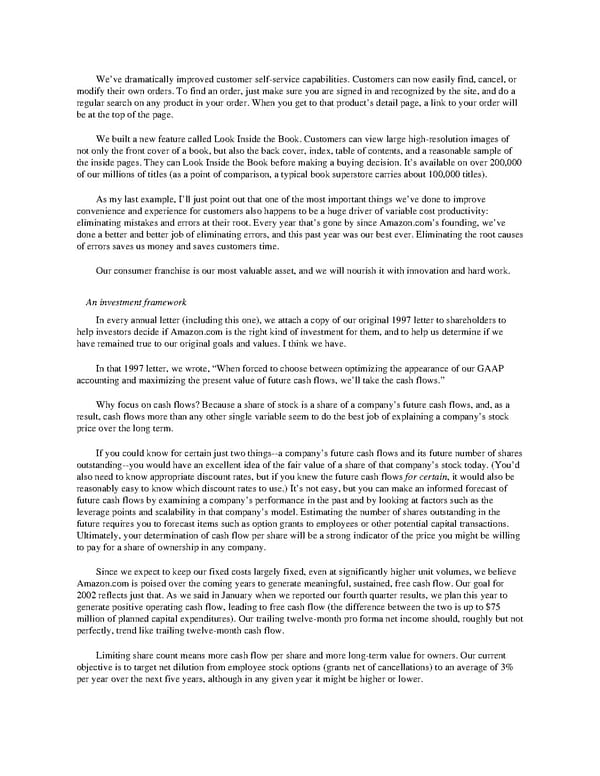We’vedramatically improved customer self-service capabilities. Customers can now easily find, cancel, or modify their own orders. To find an order, just make sure you are signed in and recognized by the site, and do a regular search on any product in your order. When you get to that product’s detail page, a link to your order will be at the top of the page. Webuilt a new feature called Look Inside the Book. Customers can view large high-resolution images of not only the front cover of a book, but also the back cover, index, table of contents, and a reasonable sample of the inside pages. They can Look Inside the Book before making a buying decision. It’s available on over 200,000 of our millions of titles (as a point of comparison, a typical book superstore carries about 100,000 titles). Asmylastexample, I’ll just point out that one of the most important things we’ve done to improve convenience and experience for customers also happens to be a huge driver of variable cost productivity: eliminating mistakes and errors at their root. Every year that’s gone by since Amazon.com’s founding, we’ve done a better and better job of eliminating errors, and this past year was our best ever. Eliminating the root causes of errors saves us money and saves customers time. Ourconsumerfranchise is our most valuable asset, and we will nourish it with innovation and hard work. Aninvestment framework In every annual letter (including this one), we attach a copy of our original 1997 letter to shareholders to help investors decide if Amazon.com is the right kind of investment for them, and to help us determine if we have remained true to our original goals and values. I think we have. In that 1997 letter, we wrote, “When forced to choose between optimizing the appearance of our GAAP accounting and maximizing the present value of future cash flows, we’ll take the cash flows.” Whyfocusoncashflows?Becauseashareofstockisashareofacompany’sfuture cash flows, and, as a result, cash flows more than any other single variable seem to do the best job of explaining a company’s stock price over the long term. If you could know for certain just two things--a company’s future cash flows and its future number of shares outstanding--you would have an excellent idea of the fair value of a share of that company’s stock today. (You’d also need to know appropriate discount rates, but if you knew the future cash flows for certain, it would also be reasonably easy to know which discount rates to use.) It’s not easy, but you can make an informed forecast of future cash flows by examining a company’s performance in the past and by looking at factors such as the leverage points and scalability in that company’s model. Estimating the number of shares outstanding in the future requires you to forecast items such as option grants to employees or other potential capital transactions. Ultimately, your determination of cash flow per share will be a strong indicator of the price you might be willing to pay for a share of ownership in any company. Since we expect to keep our fixed costs largely fixed, even at significantly higher unit volumes, we believe Amazon.comispoised over the coming years to generate meaningful, sustained, free cash flow. Our goal for 2002 reflects just that. As we said in January when we reported our fourth quarter results, we plan this year to generate positive operating cash flow, leading to free cash flow (the difference between the two is up to $75 million of planned capital expenditures). Our trailing twelve-month pro forma net income should, roughly but not perfectly, trend like trailing twelve-month cash flow. Limiting share count means more cash flow per share and more long-term value for owners. Our current objective is to target net dilution from employee stock options (grants net of cancellations) to an average of 3% per year over the next five years, although in any given year it might be higher or lower.
 Amazon Shareholder Letters 1997-2020 Page 23 Page 25
Amazon Shareholder Letters 1997-2020 Page 23 Page 25